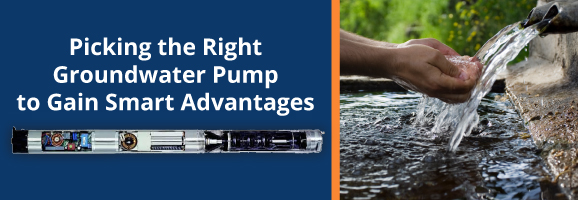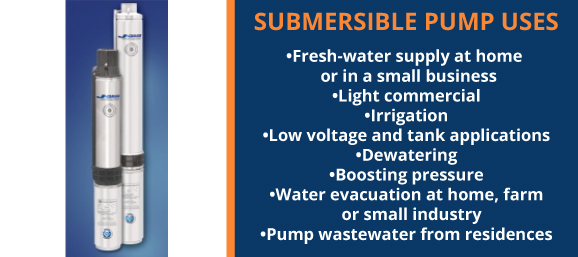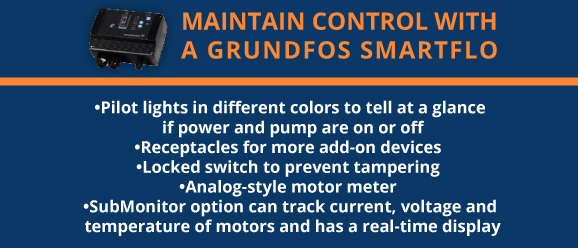Groundwater Matters: Pick a Proficient Pump to Gain Smart Advantages

All living things need water. The universal solvent flows from the ground and falls from the sky, and we turn on our taps to wash or drink without thinking about the work, thought, legislation, science, and probably worry, that goes into managing water.
From homeowners and those with small businesses to the highest-level environmental scientists and corporations, everyone wants good water for humans and animals to drink. The nation goes to great lengths to protect, manage, conserve and coordinate the water connected everywhere by rivers, aquifers, water tables, wetlands and other conveyance systems.
Some parts of the world don't have enough water and others seem to have too much. What seems like a simple, natural resource essential for life is also serious business. It's easy for anyone to take for granted that water will be there when we want to do any number of things with it.
There needs to be enough of the finite resource for public safety, industry, business and wildlife for a whole variety of reasons. With the undisputed importance of water in mind, Environmental Equipment and Supply strives to help anyone who needs to extract it or most other liquids, by offering pump sales and service, repair and testing, retro-fitting, parts and service.
Who Pumps Water and Why?
The list of different people using all kinds of submersible, suction, inertia and bladder pumps, as well as water bailers, includes many:
- Home and land owners
- Property managers
- Environmental scientists
- Natural-resources specialists
- Business owners
- Hydrologists
- Public works personnel
- Engineers
- Well technicians
- Water-quality inspectors
- Corporate managers
- Geologists
- Plumbers
This list and its sublists go on to include many kinds of people trying to bail water from the basement, perform due diligence for a land-development project, operate a farm, conduct research for the state or federal government, provide consulting advice to any number of clients and more.
We use pumps for testing, sampling, bailing and clearing water in all sorts of site-specific situations from those at home and in the neighborhood to those in small and large commercial and industrial applications:
- Dig a new well
- Close an old well
- Clear water from a construction site
- Monitor a river or other water body
- Evacuate liquid from an unwanted place
- Handle very cold or hot water
- Sample groundwater
- Manage agriculture
- Investigate a geothermal system
- Check water quality
- Conduct geotechnical studies
- Detect contamination
- Identify soil or rock permeability
- Maintain a pool or fish tank
For all kinds of scientific and personal reasons, people need the power of a pump but could use guidance in choosing from among hundreds of models; each equipped to do a number of jobs.
What Kinds of Pumps Do Which Jobs?
There are pumps that create constant pressure, move water away from a foundation and help complete due diligence, according to the regulations that recommend a purge-bail-pump process.
Grundfos and Franklin Electric are some of the large pump manufacturers that create reliable products in gallon-per-minute (gpm) capacities from one to 1,000 and diameter sizes ranging 3 to 10 inches. Whether you work personally or professionally with water, known chemicals or some murky liquid, there's a pump designed to fit your specific application.
For example, the Redi-Flo environmental pump is made especially for groundwater monitoring, sampling and remediation applications. Parts, materials, flows, pressure, capacity, speed, construction, seals and shafts all make a difference in your pumping project.
If you're working with difficult materials, you'll want a pump and parts that hold up to the job. While the composition options are practically endless, the most popular choice is usually stainless steel, Teflon™ or a combination of the two, but others include polyethylene, iron, titanium and more. The EPA advises the stainless-Teflon™ combination and to avoid materials like rubber, plastic or bronze that may interfere with the chemical integrity of the sample, though PVC construction works fine for many applications.
Another good example is the Tri-Seal technology in the Sandhandler pump for places where sand and silt make work more difficult. A system of three seals works together to keep materials out of the pump and motor; specifically, a ceramic sleeve to protect the pump’s shaft and components that resist wear from abrasive materials.
Some professional scientists use dedicated sampling equipment whenever possible to prevent cross contamination of the pumps. Many people turn to experts like Environmental Equipment & Supply for a recommendation of what kind of pump may best suit their needs and others may prefer to go it alone. Either way, it's helpful to know a few, basic characteristics of the different kinds of pumps.
Advantages of Submersible Pumps
They operate under the surface of the liquid and push it upward. The motor might be designed to run in the water or, more commonly, is kept dry in a hermetically sealed unit that is connected by a shaft. They are available in single- and multistage units that attach to riser pipes, hoses and other outlets, and a watertight cable supplies power to the submersible pump. They provide efficient operation compared to placing a pump a few feet away from the liquid source. The submersible pumps self-prime, plus require little interaction.
An array of models offers a high pumping rate depending on the size and depth, and the submersible pump offers excellent reliability, a light weight and protection against low voltage, lightning and low water levels. A few submersibles now run on solar power, and there are battery-powered options as well for those challenged by the lack of a nearby power source.

Grundfos makes a 3-inch submersible pump that provides the performance of a 4-inch without using as much energy, and with flows from 5 to 30 gallons and depths of up to 600 feet. Submersible pumps are easy to install and don't require much, if any, extra hardware or assembly. They include an electronic control that protects the pump from damage by stopping it anytime water flow ceases, then it automatically restarts when water flow resumes.
Inside it features permanent magnets in a brushless motor with built-in protection against overload and voltage instability. It starts softly to avoid disturbances, and the motors are available in multiple choices of volts and horsepower. It can be stopped then started again immediately.
Such include:
- Fresh-water supply at home or in a small business
- Light commercial
- Irrigation
- Low voltage and tank applications
- Dewatering
- Boosting pressure
- Water evacuation at home, farm or small industry
- Pump wastewater from residences
Advantages of Contact Bladder Pumps
This type of pump is best known for its ability to retain the integrity of a water sample since it keeps air from touching it, which prevents cross contamination from well to well or site to site. They need a power source and compressed-gas supply, but are not complicated equipment to use. Contact bladder pumps can be run at low or variable flow and pressure rates, and the pumps are often suited to applications in wells less than 100 feet deep.
Uses include:
- Prevent cross contamination
- Purge wells
- Sample groundwater
- Sample VOC groundwater
Advantages of Inertia Pumps
These are also known as foot valves. They supply a fast method of purging water and are particularly effective in shallow wells of 2 or less inches in diameter. Inertia pumps are portable, easy to find and cost-effective. You operate it manually, and the pump fits well when you don’t quite need a submersible but the application is too deep to bail by hand. Some inertia pumps can be decontaminated to use again, some don’t need decontamination and others are disposable.
Uses include:
- Sample groundwater
- Collect volatile organic chemical (VOC) samples
- Purge water
- Develop wells
- Accommodate sand or silt conditions
Advantages of Bailer Pumps
Bailers purge water fast and are capable of removing stagnant water first. They're easy to find, inexpensive and can cut the possibility of cross contamination. Water bailers are portable and don’t need a power source.
They're usually made of stainless steel and Teflon™ to provide years of accurate service. There are models that take one-time samples, such as when purging a well, to save you the trouble of a thorough cleaning between each well. Some scientists use a submersible pump for purging and a bailer for sampling.
The bailer pump will take groundwater samples from different depths without mixing the samples using an exclusive ball-and-valve technology. They're available in sizes from a half-inch to 2-inch diameters and lengths up to 4 feet. Water well bailers are small and portable enough for one person to use, and they require only a cable so are ideal for places where accessibility is a challenge.
These include:
- Purge wells
- Sample groundwater
- Sample surface water
- Sample vapors
- Pump well water
- Dewater construction or residential sites
- Wash with high pressure
- Irrigate
- Serve as standby for firefighting
- Evacuate seeping water
Advantages of Multistage Centrifugal Pumps
These pumps are easy to use and good for depths up to 26 feet. They self-prime and have their own control system as well as built-in technology to protect against electrical overload, overheating and running dry. Centrifugal pumps come in four sizes so are popular choices for everything from private homes and summer or getaway cabins to farms, community gardens or enhancing the performance of a local water supplier.
A line of vertical centrifugal pumps comes in nearly any size and with special configurations to match your usage if needed. The pumps accommodate applications that range from water treatment and pressure boosting to industrial processing and washing systems.
Uses include:
- Circulate water
- Transfer liquid
- Boost pressure
- Power high-pressure sprayers
- Pump for general purposes
A word on wells: Any well pump must be well fitted and suited for its application to settle in and give you years of reliable service, so take meticulous care to measure and size it correctly. Better yet, save yourself the headache by consulting a professional at Environmental Equipment and Supply.
A popular choice for residential wells is the Franklin Series V residential pump for wells that performs efficiently even where sand and sediment are challenges. It comes in a stainless steel model or one of thermoplastic resin, and its capacities range from 5-25 gpm and from a half horsepower up to five. The pump features a suction screen to filter out sand or dirt and, with proper installation, it can last up to 25 years.
Under Pressure
Ever become frustrated by substandard water pressure? The shower isn't quite the refreshing experience you want, and no two water utilities can be turned on at the same time, like the washer and sink. Some homeowners and business managers may not know they can achieve steady, reliable water pressure throughout the home, shop or business with a constant pressure controller and/or a constant pressure pump.
Everyone has options for added pressure with controls that are compatible with most systems, fit most pumps and motors, and offer adjustable settings for psi. The Grundfos submersible 3-inch pump is lightweight and easy to use, yet powerful enough to deliver the reliable pressure everyone likes. An SQE pump, for example, gives flows from 5 to 300 gpm at depths up to 600 feet. The pumps will stop themselves if water stops, plus they have built-in protection against voltage fluctuations.
Maintain Control
Control panels such as the Grundfos SmartFlo are available for monitoring and remote operations and can include many features to fit a specific application:
- Pilot lights in different colors to tell at a glance if power and pump are on or off
- Receptacles for more add-on devices
- Locked switch to prevent tampering
- Analog-style motor meter
- SubMonitor option can track current, voltage and temperature of motors and has a real-time display
All the features aim to give you more control and more information to monitor, purge, test, slow down, speed up or pump out water in a number of environments. Water is important and so is your time, and the right choice of pump can benefit both.
Find out more about smart pump choices by contacting Environmental Equipment and Supply, which has over 25 years of experience serving customers' needs for pump sales and service, repair, retro-fitting, parts and service.

